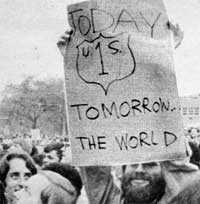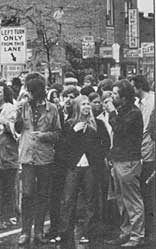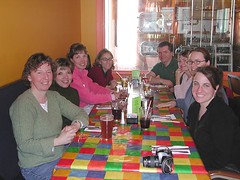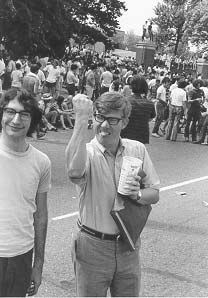How many reports do you need to tell you that Rt. 1 in Prince George's County "needs to improve"?
 Student protest on Rte. 1, College Park, Maryland, during the Vietnam War. Photos from University of Maryland Activists Re-Unite!.
Student protest on Rte. 1, College Park, Maryland, during the Vietnam War. Photos from University of Maryland Activists Re-Unite!.I find it interesting that considering that the University of Maryland is in the top 20 public universities for research grant dollars (see this Baltimore Sun interview with the president of the University of Maryland, "His mission: move UM into top tier"), that if you do a websearch on "creative class" and "Prince George's County," you get 236 hits (although that is up from less than 90 as of January 2005).

Given that the University of Maryland has a decent planning school, I'm not sure why College Park, which already has a Rte. 1 corridor revitalization effort, and the Gateway Arts District from Mt. Rainer to Hyattsville, has indicated that Rte. 1 "needs work" or is a "diamond in the rough" feels the need to get a report from the EPA on why they should improve Rte. 1, but the UMD student newspaper informs us that this is so, in the article "Main Street feel may be closer for College Park: City to consider EPA’s guidelines for Rt. 1."
From the article:
University students may be another step closer to having the ultimate college town atmosphere in downtown College Park, complete with shops and restaurants on a tree-lined, pedestrian-friendly Route 1. In an attempt to quell mounting traffic concerns and create a more aesthetically pleasing city, the College Park City Council will hear recommendations from the Environmental Protection Agency tonight on ways to improve the blighted Route 1 area.
Representatives from the EPA’s Office of Policy, Economics and Innovation will present a report at tonight’s council meeting containing recommendations on how to streamline traffic along the busy road and also create a “Main Street” feel.
College Park and Hyattsville have an incredible opportunity along their sections of Rte. 1 to create the county's version of Takoma Park or Richmond's Carytown or Baltimore's Hampden Village, leverage the historic building stock still extant, and create a center for independently-owned and operated retail as a counter position to the County's efforts to attract gobs of chain retail to a community which is underserved I suppose in that department.
A piece of how Hyattsville could go about doing this was laid out in this study, Community Legacy Revitalization Plan, which reads pretty well. Although it doesn't go far enough to my way of thinking, e.g. it didn't recommend the Main Street Approach, but it's not bad all and all.
(Although I think Hyattsville needs to drop its slogan immediately--"Hyattsville: A good place to live"--and replace it with something like "Hyattsville--Prince George's [or Maryland's] Rising Star!" But that would require that Hyattsville believe in and execute such a tagline...)
Franklin's Brewpub, and the Nelson Gallery in Hyattsville, and Maryland Book Exchange (the college textbook store) and the row of restaurants in College Park offer possibilities... So does my idea of creating a streetcar line from Rhode Island Metro to Laurel, but that's not something that DC would work on as part of the DC Streetcar studies, it's an initiative that Prince George's County would have to move forward on its own.
 Franklin's inside, from Tacky Treasures.
Franklin's inside, from Tacky Treasures. W. Lee Johnston, before he became Professor of Political Science, UNC-Wilmington, during 1970 protest on Rte. 1. Photo from his website.
W. Lee Johnston, before he became Professor of Political Science, UNC-Wilmington, during 1970 protest on Rte. 1. Photo from his website.Index Keywords: urban-revitalization



0 Comments:
Post a Comment
<< Home